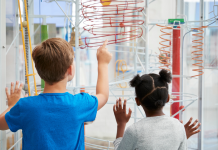Trick or treating is a Halloween tradition that children look forward to all year long. The dressing up, staying out late (oftentimes on a school night!), and of course, the CANDY all make for a fun night for everyone, right? What about the kids that face certain challenges that can make trick-or-treating more stressful than fun? Here are some tips to help ensure that all children feel safe, included, and most importantly: HAVE FUN!
The Teal Pumpkin Project
When you are a child with a food allergy or have food restrictions due to diabetes or celiac disease, there is a lot of candy that is not safe for you to eat. The Purpose of The Teal Pumpkin Project is to raise awareness and to establish a more inclusive Halloween for those with food allergies. To participate in the Teal Pumpkin Project, you place a teal pumpkin on your doorstep that communicates your house is allergy-friendly and that you have non-food items to offer to those with food allergies. Some easy affordable options could be bubbles, glow sticks, pencils, erasers, bouncy balls, or stickers. This is an easy way to make sure all kids with food allergies or dietary restrictions feel included in trick-or-treating.
The Blue Bucket
For autistic children (and parents), certain aspects of Halloween can be stressful. How many times have you heard another adult complain about kids who don’t say “trick-or-treat” or “thank you?” Some autistic children have trouble with speech and/or eye contact. People passing out candy may interpret this behavior as rude when it’s something the child simply doesn’t have control over. A blue Halloween bucket is meant to identify an autistic child. This can help adults passing out candy to extend grace to these children who may be facing challenges we know nothing about.
Be accessible.
For kids who have trouble walking or who use a wheelchair, accessibility is everything. Consider positioning yourself at the end of your driveway or at the bottom of any steps to avoid causing children with physical disabilities to feel left out. When thinking about how a child in a wheelchair feels trick-or-treating, I can not imagine the number of houses that are “off-limits” to them due to the lack of accessibility. Also, always have the front of your home well lit. This will help decrease trips and falls.
No costume? No problem.
Another thing to take into consideration is sensory processing disorder. Ever see a child trick-or-treating who isn’t wearing a costume? Or maybe, they’re covering their ears, refusing to go the house playing loud scary music? For children with a sensory processing disorder, they are typically more sensitive to lights, smells, noises, taste, or touch. Depending on the child, this may mean they have a hard time with the itchiness of a costume or being surrounded by so many different people and noises.
Skip the strobe lights and smoke machines.
Many people probably don’t realize the impact a seizure disorder can have on someone’s life, especially that of a child. Children who have seizures may be triggered by strobe lights, which is a common occurrence during trick-or-treating. Similarly, children dealing with asthma or other respiratory diseases may be affected by smoke machines. If you know someone with a seizure or respiratory disorder who may be out trick-or-treating in your neighborhood, it might be a nice idea to forego the strobe lights and smoke machines this year.
Let kids be kids.
A group of teenagers may receive quite a few looks and comments when trick-or-treating. Many people believe trick-or-treating is just for younger kids. Let’s all try and keep an open mind when we see a group of teenagers trick-or-treating on Halloween night this year. Maybe that teen boy was invited to a party where he knows drugs and alcohol will be present. Maybe he chose to go trick-or-treating because he was trying to choose the safer, more responsible option. As we all know, adulting is hard and childhood goes too fast. Kids of all ages deserve to enjoy trick-or-treating.
I think we can all agree that Halloween and trick-or-treating should be accessible and enjoyable for all children. I think that by making a couple of accommodations and keeping certain things in mind when passing out candy, trick-or-treating can be something that everyone looks forward to and enjoys.













